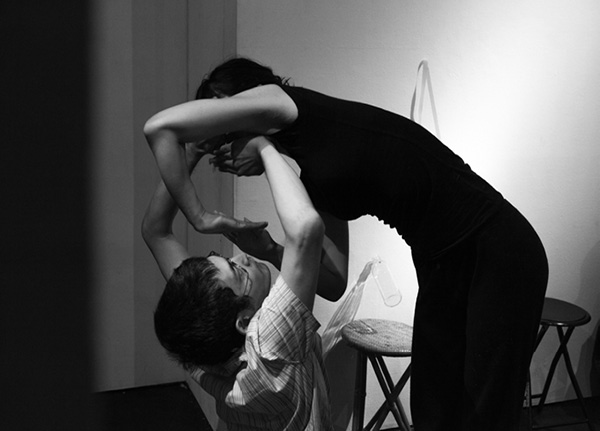
GRIP
first performed on September 28-9, 2012
Art Center Ongoing, Tokyo, Japan
performed once in 2012
ZEN-GO
Megumi Kamimura, Shinichi Takashima
Tokyo, Japan
693478260u693478260n693478260i693478260t693478260.693478260z693478260e693478260n693478260g693478260o693478260@693478260g693478260m693478260a693478260i693478260l693478260.693478260c693478260o693478260m
GRIP
ZEN-GO
“Grip” is a performance in the form of exhibition, presented by two performers for four hours. The audience may visit the gallery at any point during these four hours and may watch the performance from any chosen spot. It is announced beforehand that the duration of the piece is 45 minutes, but the decision to leave is entrusted to each audience. In the gallery there are objects which are all “containers without grips”: a steel can, hemp sack, basin, hat, ashtray, etc. Performer A depicts the objects only with his movements but without any tools. Starting with tracing the outlines of the objects, by the end, he aims to draw the motion lines connoted within the objects. The basic task of Performer B is framing, to make the audience focus attention on A’s movements by positioning his own body or marking his territory with adhesive tape.
What is “to input” in dance? Normally the action of seeing is put aside by dancers who follow the instructions of choreography. Even if they activate their perception, it is in service of synchronizing movements or making formations with other performers. Dance generally requires more attention to inner sensation or physicality than active observation of surroundings.
We’d like to take perceiving as an action. Specifically, we focus on the reflection process between seeing and depicting, a process which is a classic problematic in visual arts. Painters look at objects to depict them, and then turn their attention to the painted figures. Repetition of this process influences the painter’s original perception of the object. In the case when the depicter cannot see his own drawing, however, he consequently becomes more like a dancer who can never see his own movements while performing. Instead of comparing the drawing and the object, the dancer must compare his own physical sensation and the object in his sight.
The audience also witnesses only the depiction, not the drawn figure. But the objects are visible near the performer, so the depicting would appear not as depiction itself, but as the action of indirectly moving the objects, or as casting spells on them.
The actions in this performance are not physical movements which eschew meanings, nor the expression of internality, but the act of representation, meant to indicate other things. In “Grip,” however, such a representation is advanced like non-figurative pantomime, or magical labor, whose target doesn’t readily appear.